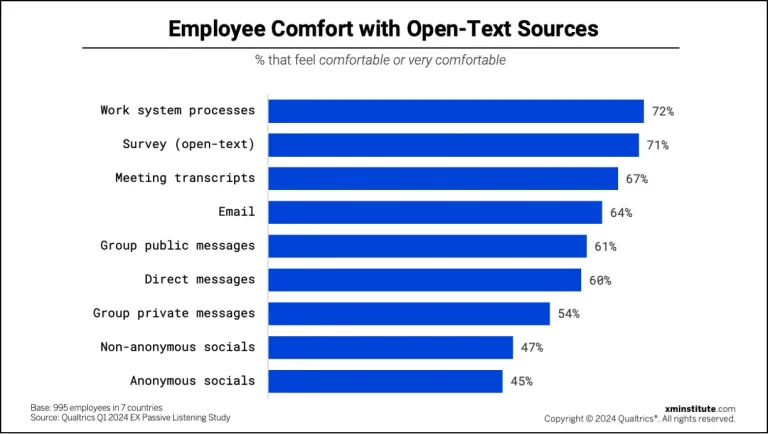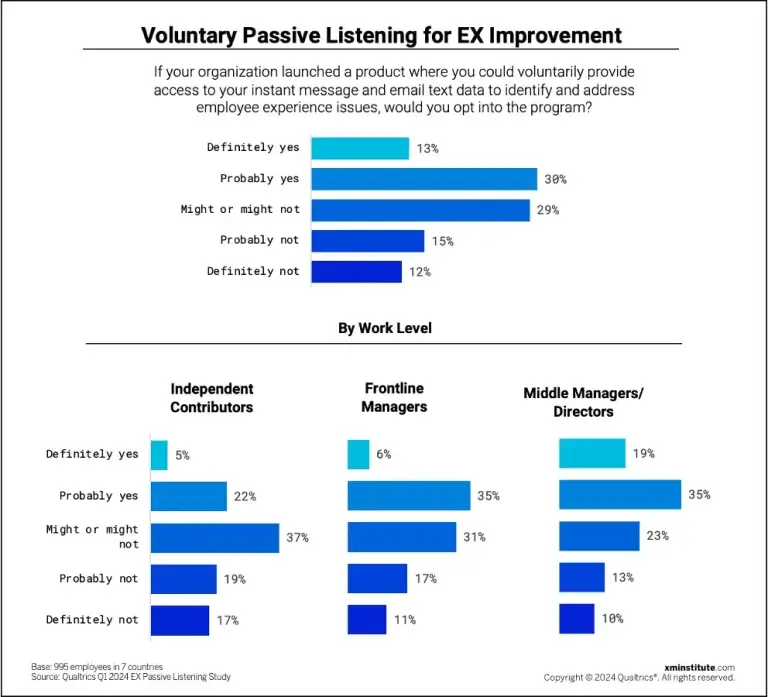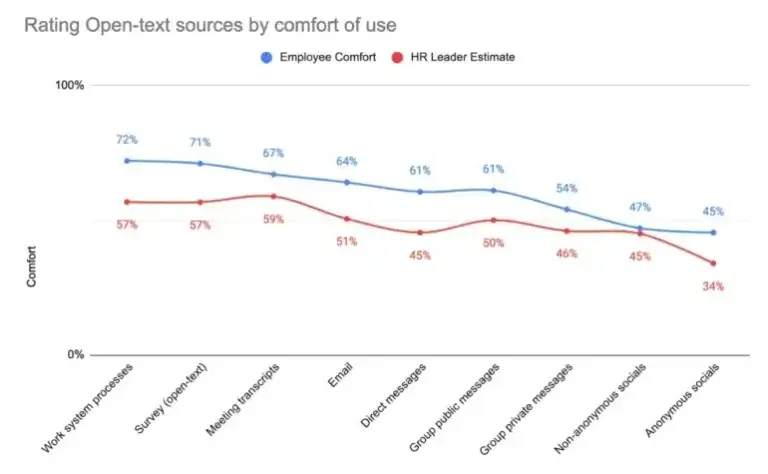Author: Ruth D’Alessandro
Subject Matter Expert: Laura Harding
We know that 77% of employees want to give frequent feedback, but not by having to fill out surveys every day.
To listen effectively to employees, you need to build a more user-friendly listening strategy. Nowadays this needs to go beyond active listening that centres around the collection of feedback. Your whole culture needs to be one of continuous listening, so that employees feel they’re being heard, treasured, and empowered to do their best work – in real time.
You need to embrace passive listening.
What is passive listening?
A definition of passive listening is this: tapping into unsolicited data (generated when a person voluntarily or passively provides feedback about an organization without the organization requesting it – often via other activities or interactions such as social media posts or support conversations) to produce more predictive, actionable insights that help enrich the overall employee experience.
Because most passive listening data is unstructured text, it’s the revolution in AI and machine learning tools that has unlocked organizations’ ability to access, analyze, and explain it, producing previously untapped insights that can help improve employee experiences and organizational outcomes.
By contrast, active listening involves taking solicited data (generated when employees or customers respond to specific requests or prompts for feedback, via surveys, questionnaires, forms or interviews), ostensibly for the same reason.
Done well, both passive listening and active listening are essential for smooth workplace communication and team collaboration.
Learn more about the Qualtrics Employee Listening Software
The importance of listening in the workplace
As we’ve touched on above, having a workplace employee listening program is essential for so many organizational outcomes, such as:
Boosting employee engagement
When people feel they are heard, they are more engaged with their organization and their work.
Employees with a very high sense of engagement (92%) are significantly more likely to feel heard than those with very low engagement (30%). And when a company listens, then acts on its employees’ feedback to make improvements, people feel they belong. And belonging is the top driver of employee engagement.
Elevating productivity
Listening helps build trust between employees and customers. Organizations are much more likely to perform well financially (88%) when their employees feel heard, and are engaged.
Building stronger team dynamics
Teamwork, confidence, morale and productivity are enhanced by listening to employees’ suggestions.
Retaining valuable talent
34% of employees would rather look for a position on a different team or even at a different company than share their concerns and views with management. By listening to employee feedback, embracing it and taking action you stand more chance of retaining your top performers before they jump ship to your competitors.
How passive listening impacts on employee experience
The upsides
Ask employees how they feel about company surveys, and many will roll their eyes. People love having their say, but survey fatigue is real – endlessly being asked to submit survey feedback on a regular basis can feel too much. And let’s not forget the HR professionals who are tasked with creating and sending those surveys, then crunching the numbers. Passive listening helps them harvest continuous, employee-centred information, saving time, and delivering accurate data.
Passive listening treads lightly on employee commitments. Unlike a survey, it chugs away in the background collecting unsolicited data as employees go about their everyday activities and communications, and people barely know it’s there. But it is, picking up the clues and hints that employees drop – consciously and unconsciously – collectively building up a picture of their experiences at work.
Declining attending a meeting, responding to a question on a public channel or emailing a customer are all data points that can be collated and interpreted by passive listening. Even existing data can be picked up without having to create new surveys.
Passive listening also harnesses the reality of what’s happening now, unconstrained by set questions or issues that happened three months ago. It also enables instant action by flagging up issues in real time so you can intervene immediately – an agile advantage in today’s unpredictable world of business and geopolitical upheaval.
The downsides
Of course, technology this sophisticated is going to present some challenges, and they are big ones that encompass ethics, regulation, and compliance. It’s important that you address these even before you begin designing a passive listening program:
1. Privacy
Employees need to be able to control the information the organization holds about them, adhering to the principle that individual data must only be used for the purpose it was shared for.
The program must be:
- Secure
- Transparent in its function
- Understood by the people whose data it uses
2. Lack of precedent
Passive listening is dependent upon AI. AI is evolving, and is being adopted, at an astonishing pace, breaking new ground every day and becoming more and more capable. Technology has never before advanced at this speed and magnitude, so it’s no surprise that many HR professionals are rightfully cautious about introducing passive listening programs. They have the task of balancing employee privacy and making sure that employees are comfortable with what they are doing.
3. Noise
Passive listening picks up everything, which means there’s a danger of it picking up nothing. Too many signals, and important pieces of information get lost in that noise. To zone in on useful data and collect it effectively you’ll need a well thought out EX strategy and a powerful platform to extract and translate the relevant data.
4. Getting employees on board
Considering employees are being told that their organization would like to listen in on everything they do during their working day, our research found, surprisingly, that 72% of respondents were comfortable with passive listening practices.
However, employees are not passive accepters of all passive listening. While 72% were comfortable with passive listening to work system processes, less than half (45% and 47%) were comfortable with social media listening:

57% of employees stated invasion of privacy as their main concern around passive listening, and 44% of employees worried about data security, expressing discomfort at the blurring of lines between their personal and professional lives just to gather feedback.
And it’s not so much fear of reprisals that worries employees – they’re more concerned with their data being misinterpreted, misunderstood or taken out of context.
We also found that the employees most likely to embrace passive listening programs are middle management (45%), and the lowest individual contributors are the least likely (5%).
This may have something to do with trust. We found that employees who trust their senior leaders are more open to embracing passive listening, and those who wouldn’t opt in were 2.5 times more negative about trust in senior leadership’s transparency. Similarly, we found that the more engaged employees are, the more likely they are to opt into passive listening.
Lastly, employees told us about the two things that are key to opting into passive listening:
- Transparency: knowing the purpose of data collection, what is shared, and who has access to it
- Having agency: being able to opt out later
Strategies to encourage passive listening
Clearly passive listening with AI has a place in organizational listening programs – employees haven’t threatened to down tools and walk out in disgust over it, quite the opposite. But that doesn’t mean it can be introduced without thought, care and consideration.
Here are our key strategies you can use if you’re considering using passive listening:
Make it transparent
Make sure that employees know what you’re going to do with their data before they volunteer it: how you’ll collect it, store it, share it and analyze it. Draw up a policy or ethical guidelines document to refer to in company communications.
Check out our Qualtrics Ethical XM Guidelines, which are written specifically for AI use cases such as passive listening.
Let employees choose to opt out
Built trust by giving employees agency over their information. You’ll have been transparent about what it’s going to be used for, now give them the choice of limiting their participation or opting out altogether.
Prioritize privacy
It goes without saying that you’ll be investing in safe, secure and ethical technology platforms for employee listening. Alongside this, you’ll need to draw up your own privacy policies that you share with employees to reassure them about data security. It should include:
- the security and storage of data collected (e.g., making sure it is encrypted and only visible to authorized personnel)
- the purpose and use limitations for the data (e.g., not using it for individual evaluations or disciplinary action
- set boundaries on data retention (e.g., expiry dates on data storage so it can be securely deleted

Tailor your communications
We’ve explored how different levels of employee view passive listening. When communicating about it, talk each level’s language, highlighting the benefits of passive listening for their specific concerns, e.g. frontline workers may be more reassured about improvements in safety on the shop floor rather than knowing opinions on work processes – which a frontline manager would jump at for strategic planning.
Challenge your own assumptions
Were you surprised that 72% of employees said they were comfortable with passive listening and AI? Sometimes, managing employee experiences and expectations for large and complex organizations can make HR risk averse to new technologies. But maybe the bigger risk is avoiding the unknown, being less innovative, and even waiting for competitors to try out new things (and get ahead) first. AI is here to stay so it makes sense to embrace it and use it for the good of the organization.
Let leaders take the lead
With middle managers, directors and the C-suite demonstrating the most willingness to see the benefits and participate in a passive listening program, it makes sense to tap into them as ambassadors.

Employees who trust their senior leaders to be transparent about the use of data are more willing to volunteer their email or instant message data (55%) whereas 53% with low trust would not. Which is why it’s essential to…
Foster organizational trust
A successful passive listening program stands or falls on one thing: do employees trust your organization? Employees that do are more willing to be monitored in passive listening programs. You can build trust by demonstrating the value of AI-enhanced processes, being transparent, protecting privacy and agency, and tangibly improving employee experience for everyone.
Measuring the impact of passive listening
An effective employee listening strategy is no longer optional; it’s essential for fostering a culture where employees feel heard and valued. By implementing continuous listening, using tools for real-time insights, and acting on feedback, you’ll drive engagement, retention, and productivity.
When you combine your employee listening strategy with an employee listening software, with its comprehensive suite of listening tools in place, you’ll go from asking for feedback to always listening for it.
By bringing in experience data from every channel, the analysis will highlight experience gaps while delivering automatic recommendations for the actions you need to take to resolve them – creating the best employee experience possible.
Learn more about the Qualtrics Employee Listening Software